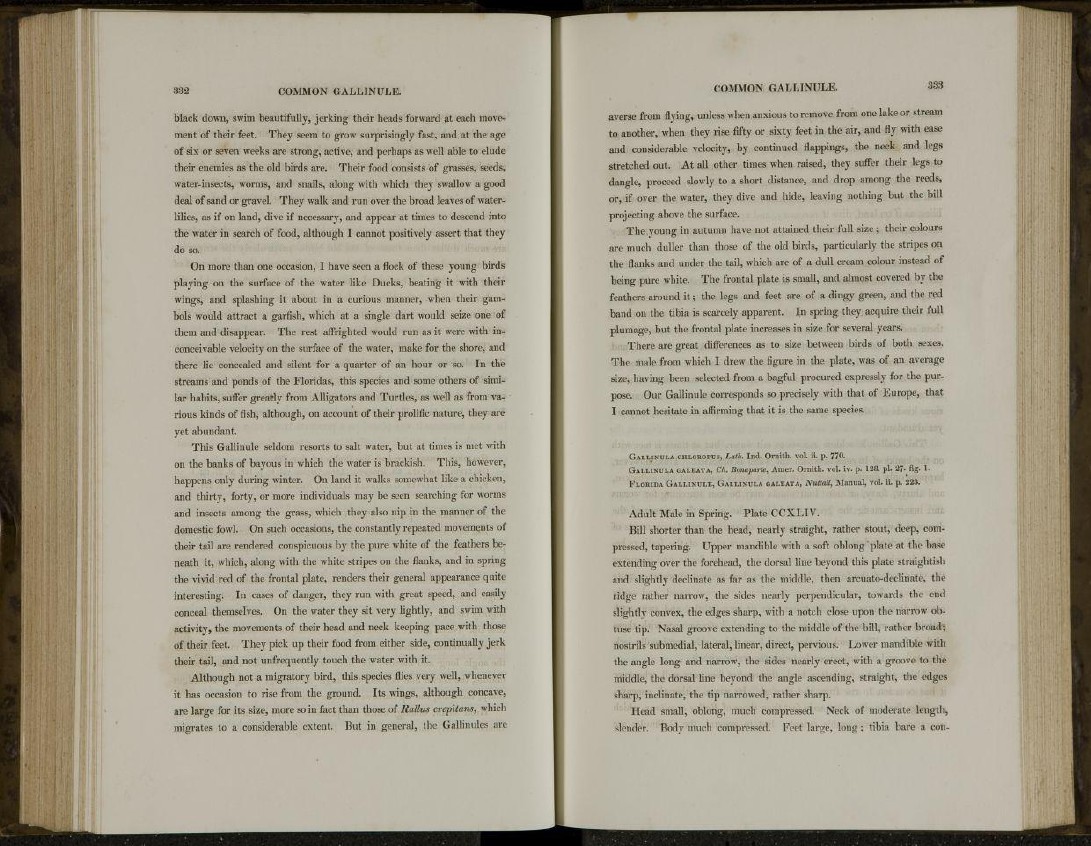
black down, swim beautifully, jerking their heads forward at each movement
of their feet. They seem to grow surprisingly fast, and at the age
of six or seven weeks are strong, active, and perhaps as well able to elude
their enemies as the old birds are. Their food consists of grasses, seeds,
water-insects, worms, and snails, along with which they swallow a good
deal of sand or gravel. They walk and run over the broad leaves of waterlilies,
as if on land, dive if necessary, and appear at times to descend into
the water in search of food, although I cannot positively assert that they
do so.
On more than one occasion, I have seen a flock of these young birds
playing on the surface of the water like Ducks, beating it with their
wings, and splashing it about in a curious manner, when their gambols
would attract a garfish, which at a single dart would seize one of
them and disappear. The rest affrighted would run as it were with inconceivable
velocity on the surface of the water, make for the shore, and
there lie concealed and silent for a quarter of an hour or so. In the
streams and ponds of the Floridas, this species and some others of similar
habits, suffer greatly from Alligators and Turtles, as well as from various
kinds of fish, although, on account of their prolific nature, they are
yet abundant.
This Gallinule seldom resorts to salt water, but at times is met with
on the banks of bayous in which the water is brackish. This, however,
happens only during winter. On land it walks somewhat like a chicken,
and thirty, forty, or more individuals may be seen searching for worms
and insects among the grass, which they also nip in the manner of the
domestic fowl. On such occasions, the constantly repeated movements of
their tail are rendered conspicuous by the pure white of the feathers beneath
it, which, along with the white stripes on the flanks, and in spring
the vivid red of the frontal plate, renders their general appearance quite
interesting. In cases of danger, they run with great speed, and easily
conceal themselves. On the water they sit very lightly, and swim with
activity, the movements of their head and neck keeping pace with those
of their feet. They pick up their food from either side, continually jerk
their tail, and not unfrequently touch the water with it.
Although not a migratory bird, this species flies very well, whenever
it has occasion to rise from the ground. Its wings, although concave,
are large for its size, more so in fact than those of Rallus crepitans, which
migrates to a considerable extent. But in general, the Gallinules arc
averse from flying, unless when anxious to remove from one lake or stream
to another, when they rise fifty or sixty feet in the air, and fly with ease
and considerable velocity, by continued flappings, the neck and legs
stretched out. At all other times when raised, they suffer their legs to
dangle, proceed slowly to a short distance, and drop among the reeds,
or, if over the water, they dive and hide, leaving nothing but the bill
projecting above the surface.
The young in autumn have not attained their full size; their colours
are much duller than those of the old birds, particularly the stripes on
the flanks and under the tail, which are of a dull cream colour instead of
being pure white. The frontal plate is small, and almost covered by the
feathers around it; the legs and feet are of a dingy green, and the red
band on the tibia is scarcely apparent. In spring they acquire their full
plumage, but the frontal plate increases in size for several years.
There are great differences as to size between birds of both sexes.
The male from which I drew the figure in the plate, was of an average
size, having been selected from a bagful procured expressly for the purpose.
Our Gallinule corresponds so precisely with that of Europe, that
I cannot hesitate in affirming that it is the same species.
GALLÍNULA CHLOROPOS, Lath. Ind. Ornith. vol. ii. p. 770.
GALLÍNULA GALEATA, Ch. Bonaparte, Amer. Ornith. vol. iv. p. 128. pi. 27- fig- 1.
FLORIDA GALLINULE, GALLÍNULA GALEATA, Nuttall, Manual, vol. ii. p. 223.
Adult Male in Spring. Plate CCXLIV.
Bill shorter than the head, nearly straight, rather stout, deep, compressed,
tapering. Upper mandible with a soft oblong' plate at the base
extending over the forehead, the dorsal line beyond this plate straightish
and slightly declínate as far as the middle, then arcuato-declinate, the
ridge rather narrow, the sides nearly perpendicular, towards the end
slightly convex, the edges sharp, with a notch close upon the narrow obtuse
tip. Nasal groove extending to the middle of the bill, rather broad;
nostrils submedial, lateral, linear, direct, pervious. Lower mandible with
the angle long and narrow, the sides nearly erect, with a groove to the
middle, the dorsal Une beyond the angle ascending, straight, the edges
sharp, inclínate, the tip narrowed, rather sharp.
Head small, oblong, much compressed. Neck of moderate length,
slender. Body much compressed. Feet large, long ; tibia bare a con